

What Is Differentiated Instruction? Click the "References" link above to hide these references.
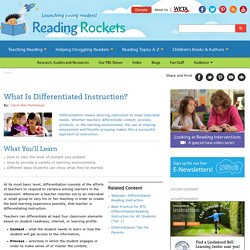
Csikszentmihalyi, M. (1997). Finding Flow: The Psychology of Engagement with Everyday Life. New York: Basic Books. Danielson, C. (1996). Enhancing Professional Practice: A Framework for Teaching. Sternberg, R. Tomlinson, C. (1995). DIBELS & IDEL Testing Materials Downloads. Materials Download Educational Use Agreement DIBELS® assessment tools and materials downloadable from this website (the "DIBELS Materials") are available to the educational entities listed below solely under the following conditions: Your use is not intended to and does not place the DIBELS Materials in the public domain.
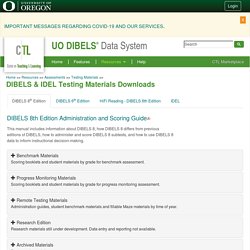
Schools, school districts and multi-district agencies may use the DIBELS Materials solely for internal educational use. No DIBELS Materials may be sold. DIBELS® is a trademark of the University of Oregon. No rights to modify DIBELS Materials or use of the trademark are granted except as agreed to in advance and in writing.
CTL is working with its development partner, Amplify (amplify.com), to launch DIBELS 8th Edition administration through mobile devices (phones and tablets) as well as computers. Dynamic Indicators of Basic Early Literacy Skills. These research-based measures are linked to one another and predictive of later reading proficiency.
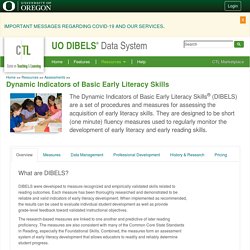
The measures are also consistent with many of the Common Core State Standards in Reading, especially the Foundational Skills. Combined, the measures form an assessment system of early literacy development that allows educators to readily and reliably determine student progress. Benchmark Screening Benchmark testing is the systematic process of screening all students on essential skills predictive of later reading performance.
Benchmark testing is one part of a comprehensive assessment system that includes universal screening, progress monitoring, summative assessments and other formal and informal assessments all designed to get the critical information needed to make informed instructional decisions. I-Ready Central Resources. Student Progress Monitoring Tool for Data Collection and Graphing (Excel) This Excel tool is designed to help educators collect academic progress monitoring data across multiple measures as a part of the data-based individualization (DBI) process.
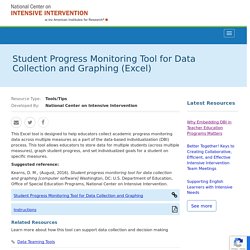
This tool allows educators to store data for multiple students (across multiple measures), graph student progress, and set individualized goals for a student on specific measures. Suggested reference: Kearns, D. M., (August, 2016). Student progress monitoring tool for data collection and graphing [computer software] Washington, DC: U.S. National Center on Intensive Intervention. Legend Convincing evidence Partially convincing evidence Unconvincing evidence Data unavailable d Disaggregated data available View Chart Resources Universal screening can be used to identify which children will need the most intensive intervention.

This tools chart has three tabs that include ratings on the technical rigor of the tools: (1) Classification Accuracy, (2) Technical Standards, and (3) Usability Features. Phonics and Decoding Assessment K-6. Phonics and Decoding Assessment K-6. Classroom Vocabulary Assessment for Content Areas. Osa (all names are pseudonyms) teaches third grade in a high-poverty urban setting with a diverse population that includes a majority of children of color and a high percentage of English-language learners (ELLs).
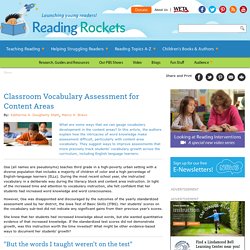
During the most recent school year, she instructed vocabulary in a deliberate way during the literacy block and content area instruction. In light of the increased time and attention to vocabulary instruction, she felt confident that her students had increased word knowledge and word consciousness. However, Osa was disappointed and discouraged by the outcomes of the yearly standardized assessment used by her district, the Iowa Test of Basic Skills (ITBS). Her students' scores on the vocabulary sub-test did not indicate any significant gains from their previous year's scores. She knew that her students had increased knowledge about words, but she wanted quantitative evidence of that increased knowledge. "But the words I taught weren't on the test" Vocabulary Assessment and Inventory Worksheets for Educators. One of the most important aspects of vocabulary instruction is vocabulary assessment.
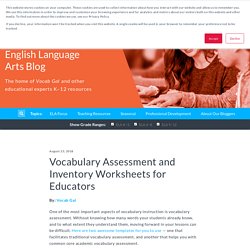
Without knowing how many words your students already know, and to what extent they understand them, moving forward in your lessons can be difficult. Here are two awesome templates for you to use — one that facilitates traditional vocabulary assessment, and another that helps you with common core academic vocabulary assessment. Download Vocabulary Assessment Worksheets now. The Importance of Pre-Assessing Vocabulary Unless teachers have an accurate understanding of their students’ competence with vocabulary word knowledge, they will not be able to comprehend what lessons students need for improvement. The best way to pre-assess students’ vocabulary knowledge is to use your vocabulary program’s diagnostic test. If teachers don't have access to a vocabulary program's diagnostic test they can use assessment charts to take inventory. English Language Proficiency Assessments for California (ELPAC) - Testing.
Program Overview The English Language Proficiency Assessments for California (ELPAC) is the required state test for English language proficiency (ELP) that must be given to students whose primary language is a language other than English.

State and federal law require that local educational agencies administer a state test of ELP to eligible students in kindergarten through grade twelve. The California Department of Education (CDE) transitioned from the California English Language Development Test (CELDT) to the ELPAC as the state ELP assessment in 2018. The ELPAC is aligned with the 2012 California English Language Development Standards. It consists of two separate ELP assessments: one for the initial identification of students as English learners (ELs), and a second for the annual summative assessment to measure a student’s progress in learning English and to identify the student's level of ELP.
The following links provide additional information about the program: Free Literacy Assessments - Mrs. Judy Araujo, Reading SpecialistMrs. Judy Araujo, Reading Specialist. Skip to content Free Literacy Assessments VectorStock Image My Favorite Free Online Assessments!
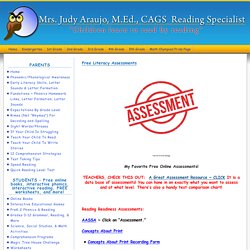
TEACHERS, CHECK THIS OUT: A Great Assessment Resource ~ CLICK It is a data base of assessments! You can hone in on exactly what you want to assess and at what level. (81) Pinterest. Placement Tests. Step 1: Giving the Reading Placement Assessments (Grades K - Middle School) If you are uncertain which assessment to administer, use this guideline: If your student will be: 5 years old this fall, give the Basic Phonics Assessment. 6 years old this fall, give the Advanced Phonics Assessment. 7 years old this fall, give Reading Assessment 1. 8 years old this fall, give Reading Assessment 2 Part A and Part B. 9 years old this fall, give Reading Assessment 3 Part A and Part B. 10 years old this fall, give Reading Assessment 4 Part A and Part B. 11 years old this fall, give Reading Assessment 5 Part A and Part B. 12 years old or higher this fall, give Reading Assessment 6.
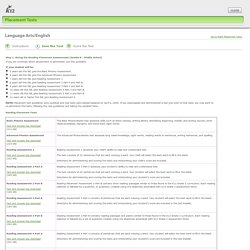
NOTE: Placement test guidelines were updated and new tests were added/replaced on April 6, 2005. If you downloaded and administered a test just prior to that date, you may want to re-administer the tests, following the new guidelines and taking the updated tests.